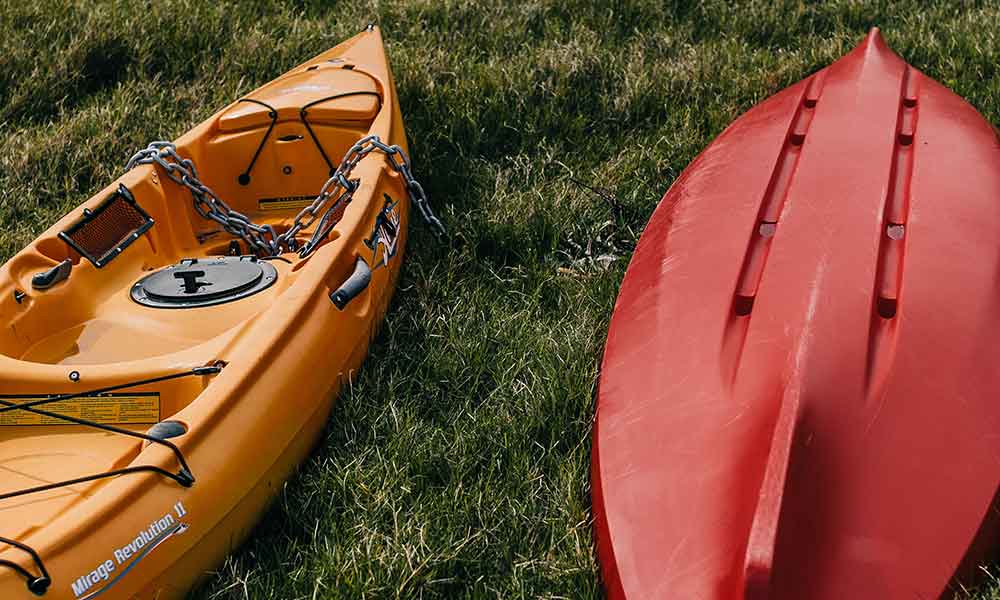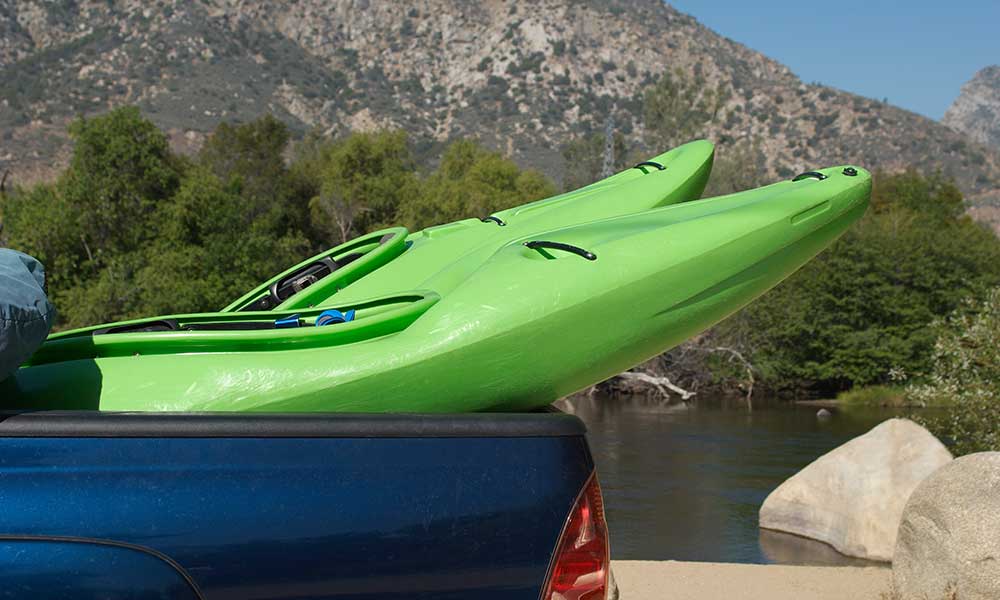Kayaks are incredible things. They allow people to see the world from a unique perspective and offer adventures and experiences that no other vessel can. However, there are some drawbacks to kayaking, and one of the major ones is lifting and carrying a kayak. What are the best ways to lift and carry a kayak?
Lifting and carrying a kayak can be done on the shoulder of one person if the kayak is small and light enough, otherwise asking a friend for help is ideal. Kayak carts are the easiest and most effective way to move a yak over land and can be stored within the boat for use when portage is necessary.
Lifting and carrying a kayak is part of owning a vessel of this type. It is important to understand the best methods and techniques for carrying and lifting a kayak to protect the boat from harm and to prevent injuring yourself. Let’s explore the best ways to lift and carry all kayaks using the safest possible methods.
What Are The Best Methods For Carrying A Kayak?
Carrying a kayak is part of owning a kayak. Everyone who uses a boat like this must move their kayak from their vehicle to the water somehow, but this can be a challenge, especially for longer boats. What are the best ways to carry a kayak?
The best methods for carrying a kayak are to use proper lifting techniques to carry the kayak on your own shoulder if you are by yourself, to carry the kayak with help from another person if that is an option, or to use a kaya cart or trolley for covering longer distances.
Lifting a kayak up onto your shoulder is a good way to carry a kayak. This is easier to do with shorter or more lightweight kayaks, but depending on your personal physical strength, this is also possible with heavier and longer kayaks.
Enlisting the help of a friend is ideal for lifting a kayak and carrying it to the water. Carrying a kayak this way ensures that the kayak is not damaged and spreads the load of the boat over the strength of two people. Kayaks typically have handles at bow and stern, which makes this method simple and ideal.
Carrying two kayaks is also possible with the help of another person. Most kayaks are light enough to carry with one arm if someone else is lifting the other end, which means that two people can carry two kayaks quite easily.
Utilizing a kayak cart or trolley is definitely the easiest way to move a kayak over land. These carts are a set of wheels and a cradle to rest your kayak on. They typically strap onto the underside of one end of the boat, and the paddler will lift the other end and pull the kayak along with the help of the wheels.
Using two carts is possible, which makes rolling a kayak very easy, and two carts can be combined with specialized attachments to increase the stability of the kayak when moving over rugged or difficult terrain.
The final and most unfavorable option is to drag your kayak along the ground. Kayaks typically have a handle at either end, which means that lifting the kayak from one end and dragging the other end along the ground is possible.
However, dragging a kayak I very likely to cause harm to the boat, especially if the kayak has a rudder or a rear keel. Composite and fiberglass kayaks should ever be dragged, but plastic boats can be dragged over soft grass or sand if necessary.
These methods are effective for moving a kayak over land, but there are some more details to discover about each method, about how to lift a kayak, and what the best ways to get a kayak off of a vehicle are. Let’s take the time to explore these aspects of lifting and moving kayaks.
How To Lift And Carry A Small Kayak
Lifting and carrying shorter kayaks is definitely easier than lifting and carrying longer boats, but there are some methods that work best for these boats.
Shorter kayaks are not always lighter kayaks. This is an important rule to remember. Just because a kayak is small does not always mean that it is lightweight. The weight of a kayak has as much to do with the materials the boat is made from as it does the size of the vessel.
With that being said, smaller kayaks are easier to maneuver when carrying and are far less cumbersome to portage. The narrower dimensions of these kayaks also make them far easier to lift up onto one’s shoulder and easier to grip for carrying over longer distances.
To lift a smaller kayak onto your shoulder, simply face the center of the kaya cockpit from the side of the boat, bend your knees, lift the kayak up onto your thighs, reach over to the far cockpit lip, and using this edge, roll the kayak up onto your shoulder. Support the kayak with both hands or use one arm to carry the kayak if you are strong enough to do so.
It is a good idea to strap your paddle to the kayak before lifting it, which will allow you to carry the kayak with both hands easily.
Once the boat is lifted up, be careful of your surroundings, as it is easy to trip when carrying a heavy boat, and it is even easier to bump into obstacles and people if you are not careful.
Using this method should allow you to carry your kayak for as long as your strength allows; however, there are alternatives.
Asking a friend for help makes carrying a small kayak very easy, and kayak carts are still a good option for moving a small kayak long distances or over rugged terrain. The only downside is that using a cart with a short kayak may be uncomfortable to pull around, as you will have to bend over to move the yak comfortably.
How To Lift And Carry A Large Kayak
Lifting and carrying a small or short kayak is one thing but lifting a large kayak and carrying a longer vessel is an entirely different task. The same is true for a kayak that is loaded full of gear and for very heavy and robust kayaks.
Lifting a heavy, long, or fully loaded kayak is simply impossible with one person. This means that rolling a kayak onto your shoulder to move it over the ground is not an option for most people.
The easiest way to move a kayak like this is to ask for help from another person. Even a very heavily loaded, a long kayak is manageable for two people if the handles on the kayak are strong enough.
The next best option or the only real option if you are on your own is to use a kayak cart. These carts are designed to make moving longer kayaks a breeze, and they perform their function very well.
Using a cart such as the RailBlaza C-Tug is ideal. These carts strap securely to the underside of your kayak, they are very unlikely to slip off, and the adjustable cradle fits almost every kayak size and variety.
Utilizing a kayak cart is easy, safe, and saves any strain from attempting to lift the kayak off the ground or up onto your shoulder. These carts also allow very heavily loaded kayaks to be moved easily and allow the boat to be rolled directly into the water, which makes launching very simple as well.
Very long or very heavy kayaks may require a second cart to ensure stability while moving the boat over land and to support the weight of the boat and its cargo well over challenging terrain. Using a cart is the easiest method of lifting and carrying a long kayak over land.
Dragging is also an option, but only if the boat is made from durable materials. Fiberglass and composite boats should never be dragged under any circumstances. Durable boats can be dragged short distances over soft ground such as sand or grass without risking too much damage.
Kayak Carts And Trolleys
Using a kayak cart or trolley is the best and easiest way to move a kayak over land from storage to your vehicle and from your vehicle to the water. There are several kayak carts available on the market nowadays, and all of them are better than nothing, but some models are better than others.
Choosing the right type of kayak cart is imperative for making moving your kayak as smooth and simple as possible. The right size, the correct wheels for the terrain you will be traversing, and the optimum design for you and your kayak type and design are all important factors to consider when choosing which kayak cart to use.
There are four basic types of kayak carts: scupper hole carts, cradle and strap carts, double rail carts, and end carts. Each type of cart has its own advantages and disadvantages, but which is best for you comes down to your preference and your gear.
Scupper hole carts are carts that have rods that fit up and through the scupper holes in a kayak. Not all kayaks have scupper holes, but if yours does, these carts are a good option. Using a cart like this does not require the use of any straps or ropes, as the scupper holes provide all of the necessary support to keep the cart stable under the kayak.
Cradle and strap carts are great as well. These carts are good for most kayak types, and they are very easy to use. These carts are typically the smallest and most lightweight kayak carts and can usually be broken down quickly and easily to store within your kayak hatch, eliminating the need for a trip to the car and keeping the cart close at hand if necessary.
Double rail carts are a universal cart type. These carts can easily accommodate any type of kayak, and they are very simple to use. Simply place the kayak on the cart rails, strap it down, and that’s all there is to it. Double rail carts can easily be used in pairs for especially long or heavy kayaks.
End carts are the most difficult to use and can only be sued on compatible kayaks, but they are very effective carts. This type of cart has a hoop that fits over the stern of a kayak, allowing the kayak to nestle within the cart rather than resting on top of the cart. This is a very secure and stable cart that is ideal for very rugged terrain and allows a kayak to be pulled along very quickly while remaining firmly attached to the boat.
Using a kayak cart is the easiest and most effective way for one person to move a kayak over land without damaging the vessel or causing any injury or harm to the paddler. These carts are simple to use, lightweight, convenient, and highly effective.
Can Kayak Carts Be Used For Portage?
Portage is another reason why many paddlers seek to improve the way they lift and carry their kayak. Sometimes moving a kayak over land during a day on the water is the only way to continue, and many wonder if using a kayak cart is a good way to do this?
Kayak carts can be used for portaging a kayak. The only consideration to make is whether or not the cart is small enough to be carried along with you while on a kayaking excursion. If so, then a cart is an ideal means of portage.
Most cradle and strap kayak carts break down into small components that store easily within the hatch of most kayaks. They are usually lightweight, and the plastic varieties typically do not add much weight to your vessel.
So long as your kayak cart can be stored in your kayak or backpack, using it is perfect for portage, makes crossing those frustrating dry sections far more tolerable, and make it easy to land a kayak and come ashore for a night of camping.
Conclusion
Lifting and carrying shorter or more lightweight kayaks is possible by lifting the boat up onto your shoulder and carrying it that way. Longer vessels are best moved with another person, but the ideal method for moving all kayak types is to use a kayak cart. Carts are simple to use, effective and make moving a kayak very easy.
Experiment with various lifting and carrying methods the next time you have your kayak out to determine what works best for you. There are many options and methods, but many are kayak-specific and dependent on how physically strong you are.
Find the best way for you, and moving your kayak over land will no longer feel like a chore but rather a straightforward and fun way of getting your boat into the water to start paddling as quickly as possible.







